Bulletin – June 2002 Australian Financial Markets
- Download 168KB
In recent years Australian financial markets have been affected by a number of structural developments that have influenced global financial markets more generally. These include: falling supplies of government debt; the introduction of the euro; falling numbers and changing behaviour of market participants; and increased use of electronic trading. In general, these developments have acted to dampen turnover in financial markets, but, nevertheless, the overall level of activity in Australian financial markets has continued to grow and market liquidity has generally remained healthy.
Total daily turnover in all financial markets in Australia averaged A$170 billion in the financial year 2000/01, an increase of 11 per cent over the previous year (Graph 1). Growth has averaged over 20 per cent per annum in the 15 or so years since financial deregulation, although growth was fastest in the first five years after deregulation.

Foreign Exchange
The most recent Bank for International Settlements (BIS) Survey of Foreign Exchange and Derivatives Market Activity[1] shows that the Australian market was one of only a few to record an increase in foreign exchange turnover between 1998 and 2001. The survey ranked the Australian foreign exchange market as the eighth largest in the world, and the AUD/USD as the sixth most actively traded currency pair.
The Australian market
Foreign exchange turnover in Australia for all currencies averaged US$52 billion per day (A$105 billion) in April 2001 (the date of the BIS survey), representing an increase of 11 per cent over April 1998 (Graph 2). Not surprisingly, the AUD/USD remained the most actively traded currency pair in the Australian market, accounting for over half of all transactions (Table 1). Indeed, most of the trading involving the Australian dollar is against the US currency, with only limited liquidity in trading of the Australian dollar against a few other currencies including the euro, Japanese yen, pound sterling and New Zealand dollar. Trading involving the Australian dollar in the domestic market grew by 14 per cent over this period, to an average daily turnover of A$54 billion in April 2001. The Australian market also sees substantial trading in other major currency pairs, with the USD/JPY and USD/EUR the second and third most traded pairs in the domestic market, respectively. Turnover involving these other currencies also grew over the three-year period, by 9 per cent to an average amount of A$50 billion per day.
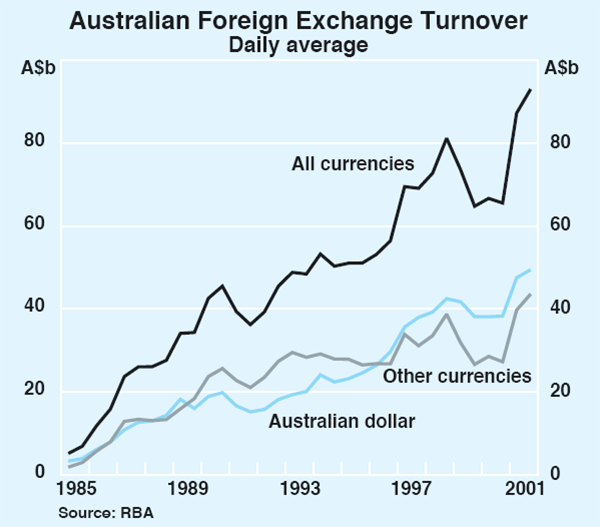
| Currency pair | April 1989 | April 1992 | April 1995 | April 1998 | April 2001 |
|---|---|---|---|---|---|
| AUD/USD | 55.2 | 40.3 | 42.0 | 53.9 | 53.3 |
| USD/JPY | 9.3 | 17.8 | 13.3 | 14.3 | 13.8 |
| USD/EUR | – | – | – | – | 10.1 |
| USD/DEM | 14.7 | 20.7 | 21.7 | 12.3 | – |
| NZD/USD | 2.2 | 1.3 | 3.2 | 5.8 | 8.1 |
| GBP/USD | 8.0 | 8.6 | 7.0 | 4.6 | 5.6 |
| USD/CHF | 5.1 | 2.5 | 2.6 | 0.8 | 1.0 |
| Other | 5.5 | 8.8 | 10.2 | 8.3 | 8.1 |
|
(a) Gross turnover (i.e. not adjusted for local dealer double counting) in spot, outright forward and foreign exchange (FX) swap transactions. Source: ‘Survey of Foreign Exchange and Derivatives Markets’, RBA Media Release 2001–20, 10 October 2001 |
|||||
The BIS survey indicated that there is also substantial trading of the Australian dollar in offshore markets, both elsewhere in the Asian time zone (mainly Tokyo, Singapore and Hong Kong) and in the London and New York time zones. Standard measures of market efficiency such as bid-ask spreads indicate a highly liquid market for the Australian dollar exists throughout the 24-hour trading day, with price discovery occurring as much in offshore trading as during Australian trading hours. This stands in contrast to many less actively traded currencies where liquidity really only exists during domestic trading hours.
The recent growth in turnover in the Australian market has come entirely through increased activity in swap and forward transactions, with a decline in the level of spot trading (Graph 3). The decline in spot trading reverses a substantial pick-up seen from 1997 to 1999 in the period surrounding the Asian financial crisis, Russian debt default and collapse of Long-Term Capital Management (LTCM), and spot activity has now reverted back to the levels of the mid 1990s.
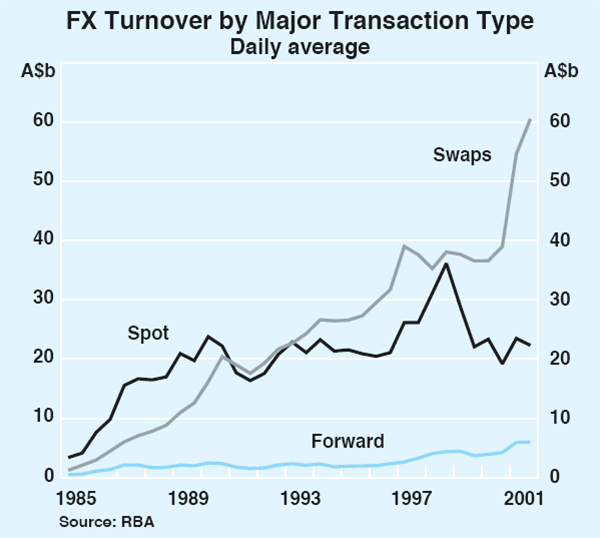
As a result of the recent trends, the share of total foreign exchange turnover accounted for by swaps has risen from around 50 per cent in the mid 1990s to 70 per cent by the end of 2001.[2] Indeed, over the course of 2001, average daily turnover in swaps rose from around A$40 billion to around A$60 billion. The growing importance of swaps reflects the flexibility that they provide for funding of foreign currency operations of banks and institutional investors.
As is discussed further below, the sharp increase in swaps turnover in the Australian market has occurred at a time when swaps activity in international markets has been declining. The large increase in swaps activity in Australia reflects both an increased use of swaps by the RBA in its domestic liquidity management and the physical relocation to Australia of Asian-time-zone currency trading by several large international banks. This relocation has reflected perceptions that Australian financial markets offer a number of advantages as a financial centre in the Asia-Pacific region. One result of the shifting of business to Sydney has been the change in the currency composition of swaps in the Australian market away from AUD/USD swaps towards USD/JPY swaps and swaps involving minor currencies. It has also resulted in an increase in the proportion of transactions that involve overseas counterparties. In terms of total swap turnover, the proportion of trades between foreign and domestic dealers increased from 60 per cent in 1989 to 70 per cent in 2001.
The BIS survey also reveals the increasing use of electronic trading systems in the Australian market and an accompanying decrease in traditional voice broker activity. As a percentage of broker activity, electronic trade has been steadily growing, currently representing almost 50 per cent of broker trade, up from just under a third in 1998.
As is happening around the world because of consolidation among financial institutions, the number of foreign exchange dealers in Australia has fallen in recent years. Nonetheless, somewhat surprisingly, the share of turnover accounted for by the top 10 dealers has been relatively stable in recent years, after increasing through much of the 1990s. The share of the 10 largest dealers in total turnover in the Australian market rose from around 60 per cent in 1989 to 80 per cent in 2001 (Graph 4). Most of the decline in the number of dealers in Australia has been among small non-bank dealers and their departure has had little impact on the market share of the top 10 dealers.
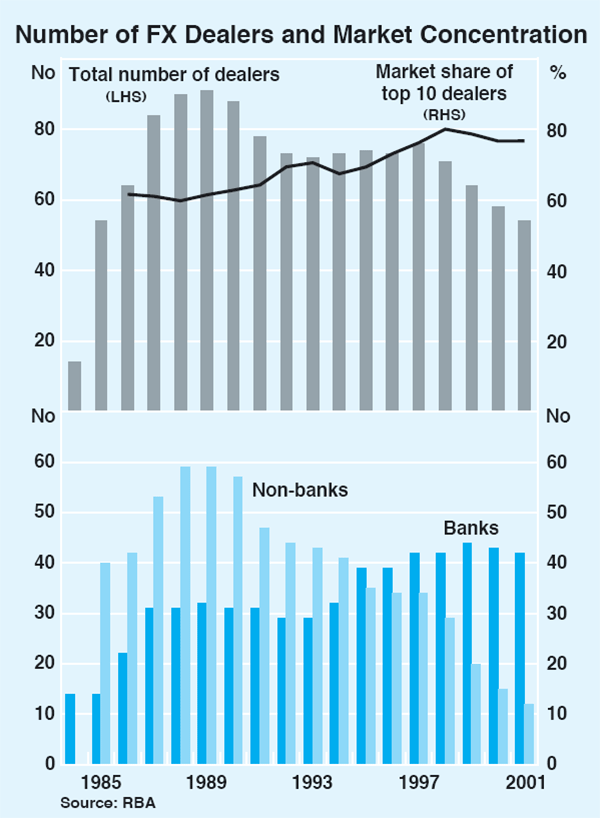
Foreign exchange derivatives market
Australian and global over-the-counter (OTC) currency derivative markets continue to grow, both in absolute turnover activity and as a proportion of total foreign exchange transactions. The increasing use of derivatives can be attributed in large part to increased hedging of both currency and interest rate risk.
Turnover in foreign currency derivatives increased by 24 per cent between 1998 and 2001, to an average of around US$2 billion per day (Table 2). As with the traditional foreign exchange market, growth has been concentrated between local and overseas dealers (with growth broadly based across different derivative products). The growing globalisation and sophistication of the Australian financial community in the types of transactions and products used is reflected in a decline in Australian dollar denominated deals, a trend consistent with previous reports on the Australian foreign exchange market.[3]
| Australia | Global | |
|---|---|---|
| Cross-currency interest rate swaps | 0.5 | 7 |
| Options | 1.6 | 60 |
| Total FX OTC derivatives | 2.1 | 67 |
|
(a) Adjusted for double counting. Sources: RBA and BIS surveys |
||
The proportion of turnover between resident dealers has been decreasing, while transactions between local and overseas dealers have risen to 56 per cent of activity, from 50 per cent in 1998. This finding is similar to the composition of global derivatives growth, with cross-border activity representing 57 per cent of activity (54 per cent in 1998).
Debt Markets
Turnover in Australian debt markets averaged more than A$90 billion a day in 2000/01, compared with A$65 billion per day in 1997/98 (Table 3). Turnover in physical and derivative markets grew at average annual rates of 10–12 per cent over this period but there were marked differences within each broad market. Within physical markets, turnover of government bonds fell while turnover of non-government bonds rose sharply, albeit from a very low base. These trends were consistent with the respective trends in outstandings. Turnover in short-term debt instruments such as bank bills, certificates of deposit and promissory notes is, by nature, much higher than turnover in (longer-term) bonds and has continued to grow strongly. Among derivative products, turnover in swaps and forward rate agreements has risen sharply over the past few years. In dollar terms, however, derivatives trading, and debt markets trading in general, continues to be dominated by trading of interest rate futures and options on the Sydney Futures Exchange (SFE).
| Average daily turnover A$ billion |
Growth over past 3 years Per cent per annum |
|
|---|---|---|
| Total physical market | 14.9 | 10 |
| Government bonds | 4.1 | −3 |
| Non-government bonds | 1.0 | 45 |
| Negotiable & transferable instruments | 9.8 | 16 |
| Total derivatives | 76.2 | 12 |
| SFE interest rate futures and options | 43.2 | 5 |
| Repurchase agreements | 20.1 | 18 |
| Swaps(a) | 5.9 | 49 |
| Forward rate agreements | 6.7 | 50 |
| Other | 0.3 | na |
| Total turnover | 91.1 | 12 |
|
(a) Includes overnight index swaps, which were included in the survey for the first time in 2000/01. Source: AFMA-SIRCA Australian Financial Markets Report 2001 |
||
The government bond market
Strong government fiscal positions have resulted in the stock of Commonwealth Government bonds outstanding falling from a peak of almost A$100 billion in 1997 to A$60 billion in early 2002.[4] As a ratio to GDP, gross Commonwealth debt has fallen from around 18 per cent to around 10 per cent over the same period. Private bonds outstanding now exceed Commonwealth plus state bonds outstanding by A$5 billion (Graph 5).

Despite these developments, the Commonwealth government bond market remains the core debt market in Australia. Two main factors have helped in this regard.
First, the Government has supported liquidity and efficiency in the government debt market by concentrating bond issues in key benchmark lines, particularly in the relatively new lines of 11–13 years to maturity, and repurchasing other (shorter-term) bonds. As a result, turnover in Commonwealth bonds in recent years has not fallen as much as debt outstanding and remains more than twice the turnover in private bonds, despite the sharp increase in the latter (Graph 6).
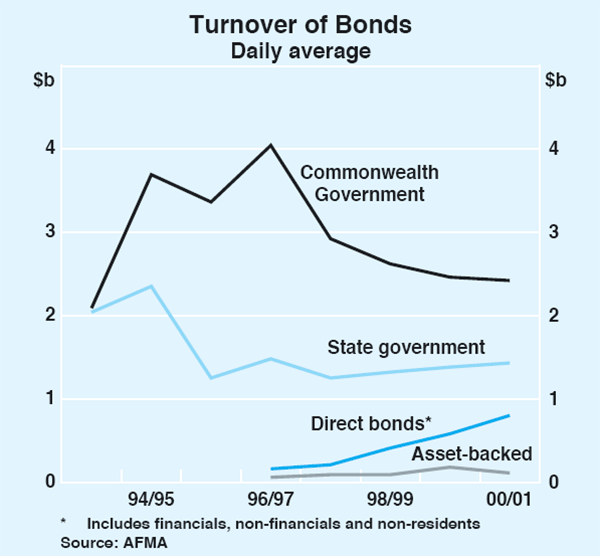
Secondly, liquidity and price discovery of Commonwealth bonds tends to be concentrated in related derivative markets rather than in the physical market. Turnover in bond futures on the SFE is about three times higher than turnover in the physical market with growth in the past couple of years (driven by activity in the 3-year contract) more than offsetting the fall in physical market turnover. Turnover of repurchase agreements, or ‘repos’, using Commonwealth government bonds as collateral, is about five times higher than turnover of physical bonds (Graph 7). The fall in turnover in repos in 2000/01 reflects some shift away from very short-term agreements rather than a decline in underlying activity in the market.
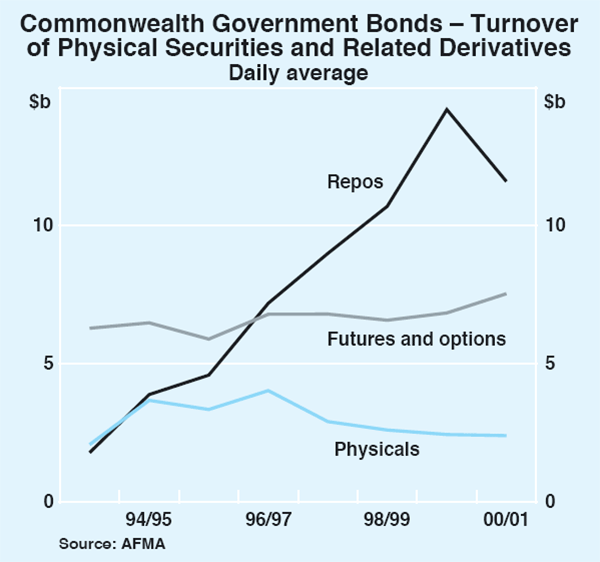
A number of market participants have argued that liquidity in the Commonwealth government bond market has been declining for a number of years, at a time of sharply increasing demand for financial assets, and has declined further in 2001/02. The available data do not, however, suggest a sharp fall of late. For example, data from SFE/Austraclear suggest combined turnover in the physical stock and repos has held up in 2001/02 while turnover in futures has risen, as has ‘open interest’ – the value of positions held open at the end of each trading day (Graph 8). Also, bond futures' price volatility has declined recently, following a rise in 2001, and currently is no greater than in 1997, when the physical stock of Commonwealth bonds was at its peak. This needs to be seen in the context of volatility across a range of financial instruments but does suggest – in the absence of hard data on bid-offer spreads – that liquidity in the market, as measured by the market's ability to withstand large trades, has not fallen markedly.
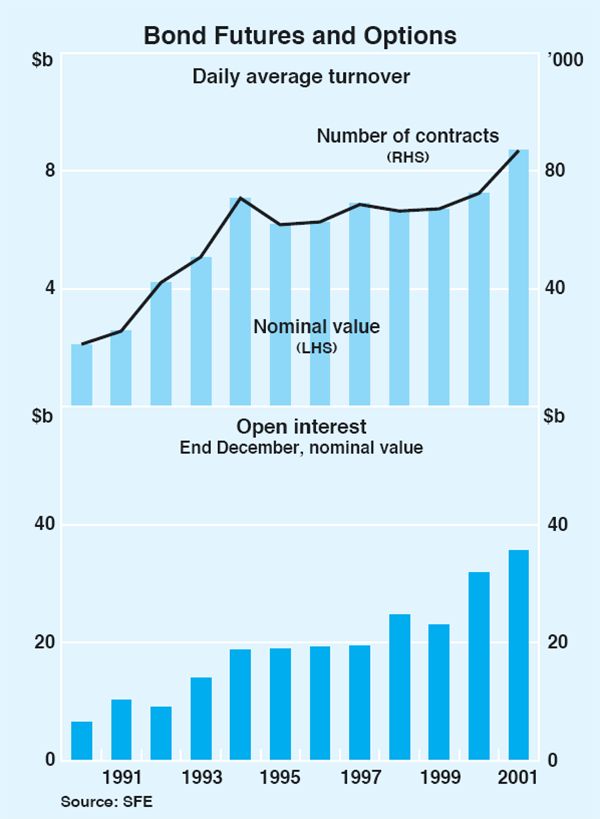
Non-government bond markets
The level of non-government bonds outstanding amounted to A$115 billion in May 2002 – a more than three-fold increase over the past three years. Non-government bonds comprise those issued by financial institutions (A$26 billion), non-financial corporations (A$26 billion), non-residents (A$21 billion) and as asset-backed securities (A$41 billion). Turnover ratios – the ratios of turnover to outstandings – for private debt tend to be much lower than for government debt, reflecting the international tendency for private debt, especially asset-backed securities, to be purchased by ‘buy-and-hold’ investors. While turnover in private debt has risen strongly over the past few years it has not outstripped the growth in outstandings. As a result, turnover ratios are still around the levels observed several years ago (Table 4).
| Sector | Financials | Corporates | Non-resident | Asset-backed | Total private | Commonwealth Government securities |
|---|---|---|---|---|---|---|
| 1997/98 | 3.7 | 8.8 | 1.7 | 1.0 | 2.3 | 8.6 |
| 1998/99 | 3.9 | 9.0 | 1.9 | 0.9 | 2.7 | 7.9 |
| 1999/00 | 2.2 | 4.4 | 1.3 | 1.4 | 2.3 | 8.1 |
| 2000/01 | 3.9 | 3.8 | 0.9 | 0.7 | 2.1 | 8.9 |
|
Source: AFMA |
||||||
Non-government issuance of short-term debt has also grown strongly. Banks and other financial corporations account for the bulk of non-government issuance of short-term debt, in the form of bank bills and certificates of deposit (CDs). Average daily turnover in bank bills and CDs is around $6 billion. Turnover in bank bill futures is about six times this figure. Short-term issuance by non–financial corporations – promissory notes – fell in 2000/01, reflecting a shift to longer-term financing.
The trends in absolute levels of turnover in government and private bond markets have been associated with corresponding shifts in the number of dealers acting as market-makers in the two markets. The number of active participants in the government bond market has fallen from 20 in 1996 to 15 in 2001. The concentration of turnover, however, has changed little, with the share of the eight largest dealers remaining around 80 per cent of total market turnover for the past five years. In contrast, the number of dealers acting as market-makers for non-government bonds has increased, from 13 in 1998 to 16 in 2001. Over that time, concentration amongst dealers has fallen. In 2000/01 the eight largest dealers accounted for 72 per cent of turnover, down from 94 per cent in 1997/98.
Electronic trading has yet to have a significant impact on the fixed-income markets in Australia. There are presently two active electronic trading platforms: a retail market trading on the ASX's Stock Exchange Automated Trading System; and a wholesale internet portal called Yieldbroker. Both systems had trading volumes of around A$500–$600 million per month in late 2001.
Over-the-counter interest rate derivatives
While futures (and options) are traded on the SFE, other interest rate derivatives – forward rate agreements (FRAs), swaps and options – are traded in the over-the-counter (OTC) market, that is, bilaterally. Box 1 discusses the nature and uses of these instruments.
Turnover in FRAs and swaps has risen sharply, from a combined average of A$4 billion per day in 1997/98 to A$13 billion per day in 2000/01 (Graph 9). Turnover in options remains very low.
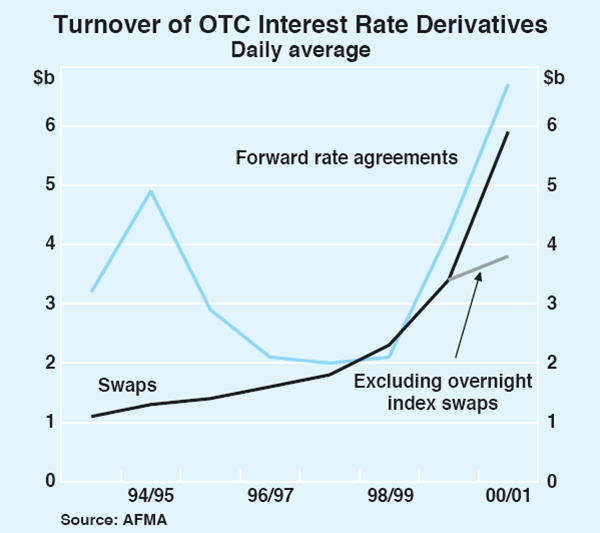
The strong growth in turnover of FRAs and interest rate swaps is associated with the rapid growth in the private bond market. This is because these instruments help investors hedge their positions in private debt markets. As with the government debt market, turnover in derivatives associated with private debt markets is much higher than turnover in the underlying market. Total turnover in OTC interest rate derivatives of A$13 billion a day in 2000/01 compares with average daily turnover of A$1 billion of non-government bonds. The rapid growth in turnover in swaps reflects the burgeoning market in (short-dated) overnight indexed swaps (discussed below), which has far outweighed the effect of some lengthening of maturities in other swaps in recent years (Graph 10).

The past few years have seen the introduction of two new swap products to Australia – credit default swaps and overnight indexed swaps (OIS). (Box 1 also discusses these instruments.)
At this stage turnover in credit default swaps is low (around A$28 billion in all of 2000/01) and trade is mostly confined to a small number of banks and investment banks. Nonetheless, use of these products by other market participants, such as funds managers, has grown markedly over the last year or so.[5] Both the Australian market and international markets have benefited from a widening in the range of credit derivative instruments and from improvements in market infrastructure, such as the introduction of standardised documentation and the development of benchmark interest rate indices that provide a basis for the valuation of credit derivatives. Since corporate bond yields underlie the pricing of many credit-derivative products, development of this derivative market and the broader corporate bond market are likely to go hand-in-hand.
Overnight indexed swaps first appeared in Australia in late 1999 but turnover has grown rapidly, averaging around $2 billion a day in 2000/01. They are discussed further in the article ‘Overnight Indexed Swap Rates’ in this issue of the Bulletin.
The Equity Market
In terms of turnover, the equity market is much smaller than the foreign exchange and debt markets. In 2000/01 it accounted for just 2 per cent of total market turnover. Nevertheless, over the past three years turnover in physical shares on the Australian Stock Exchange (ASX) has grown at an average rate of 20 per cent, while turnover of associated derivative products has grown by 12 per cent per annum (Table 5).
| Average daily turnover A$ billion | Growth over past 3 years Per cent per annum | |
|---|---|---|
| Physical market | 1.7 | 20 |
| Derivatives | 2.0 | 12 |
| Total turnover | 3.7 | 16 |
|
Source: AFMA-SIRCA Australian Financial Markets Report 2001 |
||
The market capitalisation of companies listed on the ASX has increased by around 40 per cent over the past three years. Price increases and new issuance – by either new or existing listings – contributed roughly two-thirds and one-third, respectively, to this growth. In December 2001, there were 1,410 companies (1,334 domestic) listed on the ASX – up 15 per cent since December 1998. Growth in the market capitalisation of existing companies has outstripped growth in the number of listed companies; the average company listed on the ASX now has a market capitalisation of around A$520 million, up 18 per cent since December 1998.
Over the past three years, share turnover has grown more rapidly than total market capitalisation. As a result, the turnover ratio – the ratio of turnover to market capitalisation – has risen, from around 0.5 in 1998 to 0.7 (Graph 11).
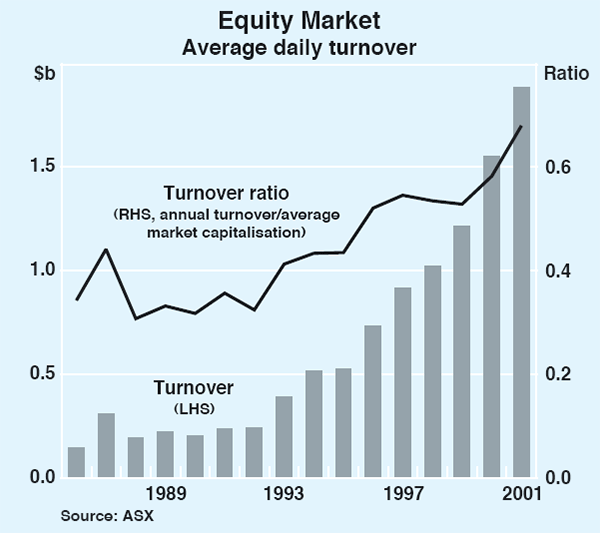
One contributing factor to increased turnover in the late 1990s was privatisations and demutualisations. The resulting broadening of household participation in the share market may not contribute to further rapid increases in turnover in the near future, however, as about a half of household share owners hold shares in only one or two companies and a similar proportion conduct transactions less than once a year.
The overall size of the equities brokerage industry has changed little over the past 10 years, with the number of active ASX members standing at 92 in June 2001 compared with 88 in 1990. The competitive environment, however, has changed considerably due to the development of online brokers. Online brokers tend to focus on the provision of ‘no frills’, low-cost brokering services, offering share trading for as little as $16 per trade. This has put downward pressure on brokerage rates more broadly. Online brokers account for about 15–20 per cent of the number of ASX trades compared with one-quarter of all trades in the US, and 4 per cent of European trades.
In recent years the ASX has taken several steps to more closely integrate the Australian market with markets overseas. In June 2000 the ASX joined multilateral discussions with the New York Stock Exchange (NYSE) and nine other exchanges to consider the feasibility of establishing a global equity market by linking their existing systems. In March 2001 the ASX began offering links with the American Stock Exchange, Nasdaq and the NYSE. These links allow Australian investors direct access to US securities including all stocks in the Dow Jones Industrial Average index and the Standard and Poor's 100 index. US securities regulations do not readily allow foreign market services to be offered directly to US investors so the linkages are one-way. In December 2001, however, the ASX and the Singapore Exchange opened a two-way link, which allows investors in each country to directly trade shares in the other market in their home currency and using their home broker.
Global Comparisons
In contrast to many financial centres around the world, the overall level of activity in Australian financial markets has remained buoyant over the past few years. As a result, Australian financial markets continue, in many cases, to rank well above what would be expected given the share of Australia's economy in the global economy.
Foreign exchange
The longer-run expansion of the Australian foreign exchange market has been broadly in line with global growth in turnover since the mid 1980s. However, as global activity markedly contracted between April 1998 and April 2001, the Australian market stood out as one of a few that experienced an increase in turnover (Table 6). This is despite some large declines in foreign exchange turnover in the Asia-Pacific region. Noticeably, the New Zealand market shrank by 46 per cent, with activity in the Singapore and Hong Kong markets falling by 28 per cent and 15 per cent, respectively. As noted earlier, part of the reason for Australia's stronger relative performance has been the relocation of Asian time-zone trading from other markets to Australia. This was particularly important in explaining the decline in turnover reported in New Zealand.
| World | Australia | |
|---|---|---|
| Spot | −32 | −33 |
| Swaps | −11 | 44 |
| Forwards | 2 | 40 |
| Total turnover(a) | −19 | 11 |
|
(a) Total turnover is adjusted by an estimated gap in reporting amounts. As a result, the total turnover does not equal the summation of the individual components. Source: BIS survey |
||
The Bank for International Settlements cites several main reasons for the global decline in activity:
- consolidation of the bank and corporate sectors;
- growing importance of electronic broking in the spot market which has reduced the amount of inter-dealer trading that used to take place; and
- the introduction of the euro.
Over the past few years the Australian market has witnessed a number of global bank and non-bank mergers, as well as domestic bank consolidation. Furthermore, the share of electronic broking increased in line with the global experience. However, in contrast with the global experience, the introduction of the euro in January 1999 did not have a noticeable impact on the Australian market. In particular, the disappearance of trading between pre-euro currencies eliminated around 6 per cent of global trading but had little effect on Australian trading since there was essentially none of this trading in the Australian market. Instead, most trading involving the pre-euro currencies in the Australian market was US dollar/Deutsche Mark trading and this has continued in the form of US dollar/euro trading.
The BIS survey shows that the Australian market accounts for 3 per cent of global turnover, ranking it as the eighth largest in the world – just behind some of the traditional financial centres such as Switzerland and Hong Kong, but ahead of some larger economies such as France and Canada (Graph 12). Furthermore, with average daily turnover of US$52 billion, the AUD/USD is the sixth most traded currency pair, accounting for 4 per cent of global turnover.
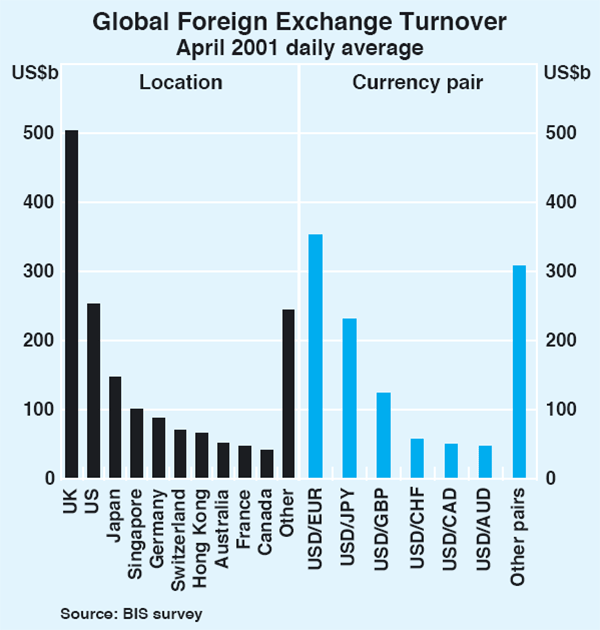
In the Asia-Pacific region, Australia hosts the fourth largest foreign exchange market, behind Japan, Singapore and Hong Kong (Graph 13). The sum total of turnover in smaller and less developed markets in the region amounts to only around half of the average daily turnover in the Australian market.
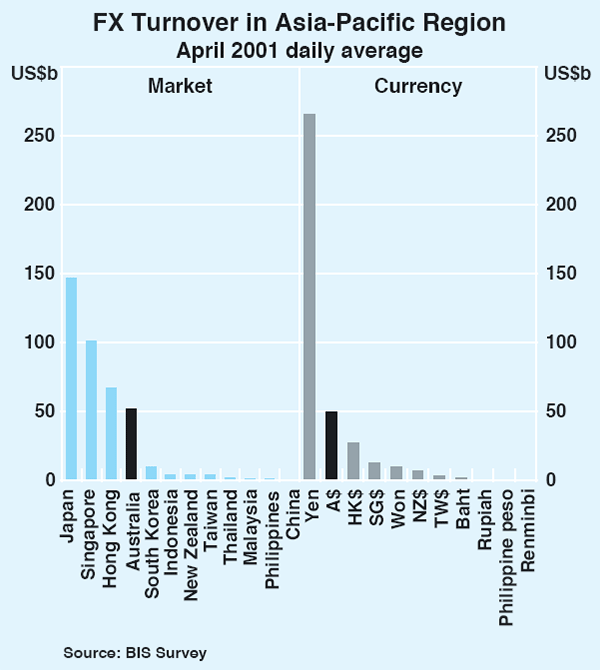
However, whereas a lot of trades in the region are currently being conducted out of Singapore and Hong Kong, the local currencies of these countries have relatively small turnover in world markets. While the Japanese yen is the most actively traded currency of the Asia-Pacific nations by a wide margin, the Australian dollar ranks a clear second, with average daily turnover exceeding that of the Hong Kong and Singapore dollars combined.
Debt markets
In terms of total outstandings, the Australian debt market ranks around 15th in the world but accounts for less than 1 per cent of outstandings.
On balance, recent trends in liquidity in Australian debt markets compare favourably with trends seen in some of the world's major debt markets, despite central government debt being retired relatively quickly in Australia. In the US, reductions in central government debt and the withdrawal of risk capital by securities dealers following the market disruption associated with the collapse of Long-Term Capital Management have caused turnover in both government bonds and bond futures to fall. In the UK, turnover of government bonds has yet to return to the levels seen in 1996 and 1997.
Within the Asia-Pacific region, Australia hosts the third largest debt market outside of Japan (Graph 14). Other debt markets in the region are generally less developed than in Australia, although some markets, notably South Korea and China, are growing quickly. Following the Asian crisis there has been a major push to develop private bond markets in the region in an effort to broaden funding opportunities and reduce the concentration of risk on the banking sector. In the case of Hong Kong and Singapore, this also involved issuing government debt (not actually needed for funding) to facilitate pricing of private debt.
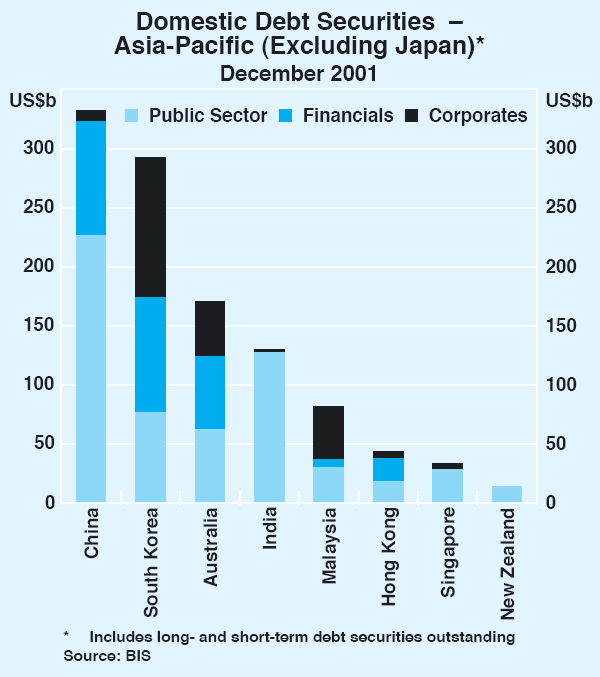
In terms of turnover in interest rate derivative markets, Australian exchange-based trading is relatively high by international standards while OTC-based trading remains low.
International comparisons of exchange-based trading are typically done on the basis of volumes. This can be misleading, however, since the size of contracts can vary significantly within and across exchanges. A better basis for comparison is the value of transactions by exchange, as reported in Table 7. The data are annualised but are consistent with a daily average for the SFE of US$23 billion, inclusive of the SPI200 contract.
| 2000 | 2001 | Percentage change | |
|---|---|---|---|
| Chicago Mercantile Exchange (US) | 125.6 | 201.5 | 60.4 |
| LIFFE (London) | 75.7 | 111.9 | 47.8 |
| Chicago Board of Trade (US) | 21.4 | 39.3 | 84.0 |
| Eurex (Germany) | 25.8 | 35.5 | 37.5 |
| Singapore Exchange (Singapore) | 18.0 | 20.8 | 15.7 |
| Tokyo Stock Exchange (Japan) | 9.9 | 6.6 | −33.6 |
| Tokyo International Financial Futures Exchange (Japan) | 15.9 | 6.3 | −60.2 |
| Sydney Futures Exchange (Australia) | 5.7 | 5.8 | 2.5 |
| BM&F (Brazil) | 3.1 | 4.4 | 40.0 |
| Total | 318.0 | 445.8 | 40.2 |
|
(a) Includes equity index futures, but excludes commodities and options on single equities. Source: BIS |
|||
Overall, the SFE is the eight largest futures exchange in the world by value of turnover. As noted earlier, liquidity and price discovery for the Commonwealth Government bond market largely resides in the futures market.
Turnover on global futures exchanges (excluding options on single equities and commodities) rose by 40 per cent in 2001, spurred on by large increases on the main European and US exchanges. Eurex, in particular, is beginning to see the benefits of the introduction of the euro, which has created large pools of liquidity for contracts such as the German government bond futures contract. Turnover on the SFE (measured in US$) rose slightly over this period.
Regionally, by value of turnover, the SFE is the third largest futures exchange, after the Singapore and Japanese exchanges (Graph 15). Daily average turnover on the SFE in 2001 was around US$23 billion. This compares with around US$85 billion on the Singapore exchange, although most of this turnover is in eurodollar and yen contracts, not domestic contracts. Australia ranked second in daily turnover of domestic currency contracts in 2001 (Graph 16). Domestic currency futures markets in most Asian countries are still very much in their infancy.
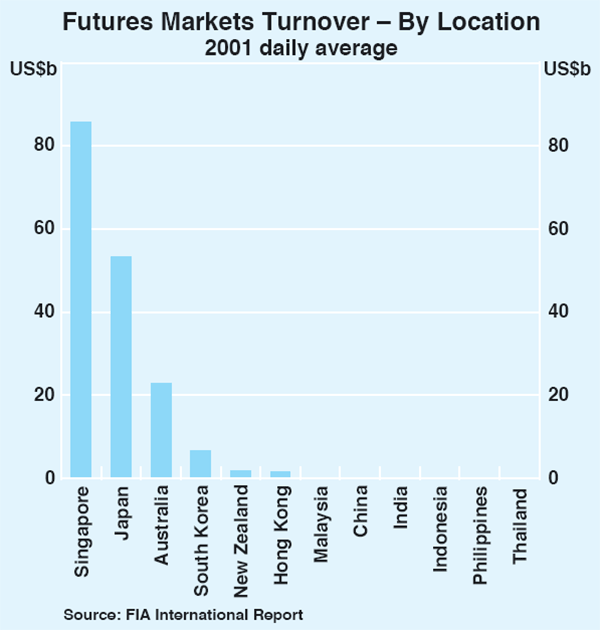

Turnover in global OTC interest rate derivative markets has, according to the latest BIS financial survey, risen strongly over the past three years (Table 8). Turnover in Australian OTC markets rose particularly quickly.
| Average daily turnover in April 2001(a) US$ billion | Average annual growth 1998–2001 Per cent per annum | ||||||||
|---|---|---|---|---|---|---|---|---|---|
| Forward rate agreements |
Swaps | Options | Total | Forward rate agreements |
Swaps | Options | Total | ||
| UK | 83.2 | 141.7 | 12.9 | 237.8 | 25 | 27 | 3 | 25 | |
| US | 23.0 | 81.5 | 11.1 | 115.7 | 13 | 37 | 0 | 26 | |
| Germany | 17.2 | 74.0 | 2.8 | 94.0 | 46 | 54 | −4 | 48 | |
| France | 6.7 | 55.8 | 2.5 | 65.1 | 13 | 20 | −10 | 17 | |
| Netherlands | 4.5 | 19.3 | 0.3 | 24.2 | 36 | 133 | 20 | 90 | |
| Japan | 1.1 | 12.6 | 2.1 | 15.8 | 3 | −11 | −45 | −21 | |
| Canada | 2.9 | 6.1 | 1.0 | 9.9 | 6 | 28 | −3 | 16 | |
| Australia | 5.5 | 4.1 | 0.3 | 9.8 | 55 | 47 | 51 | 51 | |
| Global total | 129.0 | 331.0 | 29.0 | 489.1 | 20 | 29 | −7 | 23 | |
|
(a) The individual country data sum to more than the global total as the global total is adjusted to exclude double counting of transactions dealt between counterparties in different countries. Sources: BIS and national central banks |
|||||||||
More recent data, for the six months to December 2001, show that activity in global interest rate derivative markets, as measured by the notional amount of OTC contracts outstanding, grew by around 15 per cent – faster than in the first half of 2001. Activity in the second half appears to have been driven by the large changes in official interest rates in the US in response to slower growth and the terrorist attacks of 11 September.
London and New York remain the most important centres for OTC derivative activity, although a number of European centres (namely Frankfurt and Paris) have benefited from the introduction of the euro.
Although Australian OTC interest rate derivatives markets remain small by global standards, they account for over 30 per cent of OTC interest rate derivative turnover in the Asia-Pacific region (Graph 17). This is despite the fact that most turnover in Australian derivatives markets is still via exchanges. Japan accounts for 50 per cent of regional turnover.
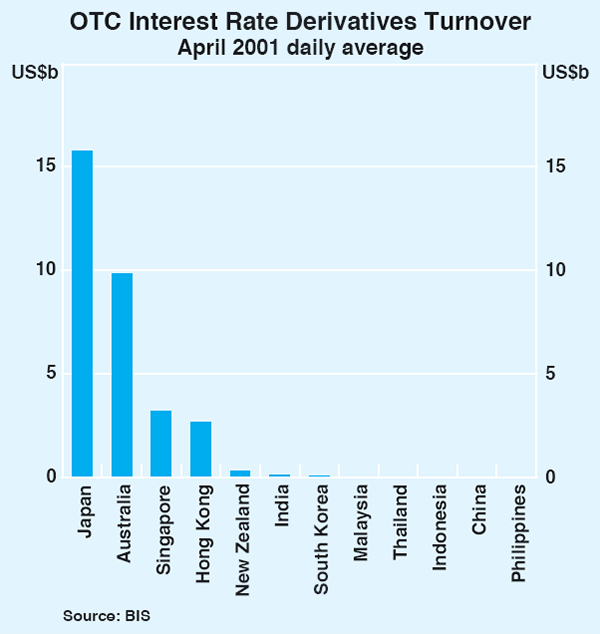
Equity markets
In terms of domestic market capitalisation the ASX was the twelfth largest stock market in the world at the end of 2001. It was the third largest in the Asian region after the Tokyo and the Hong Kong exchanges. In the Morgan Stanley Capital Index (MSCI), Australia has a global weight of around 1.5 per cent and ranks tenth. It has a weighting of nearly 35 per cent, up from 26 per cent in May 2001, in the MSCI Asia-Pacific ex Japan index.[7] The rise in Australia's weight is due to the move by MSCI to adjust each stock's index weight for holdings that are not freely tradable (i.e. strategic investments held by investors such as governments, controlling shareholders or company management are subtracted from each company's market capitalisation). Compared to other countries in the Asia-Pacific region, the proportion of shares listed in Australia that are freely tradable is quite high.
While liquidity in the Australian equity market remains below that of the largest markets in the US and UK, it is around the median for all developed markets. The value of trading on the ASX grew by more than 20 per cent over 2001 (in US$), while activity on the London Stock Exchange, the New York Stock Exchange (NYSE) and the Nasdaq all fell (Graph 18). Trading on the Nasdaq has been particularly affected by the rise and fall of activity in new-technology stocks. Activity in the main Asian share markets in Tokyo, Hong Kong and Singapore has also fallen over the past two years.
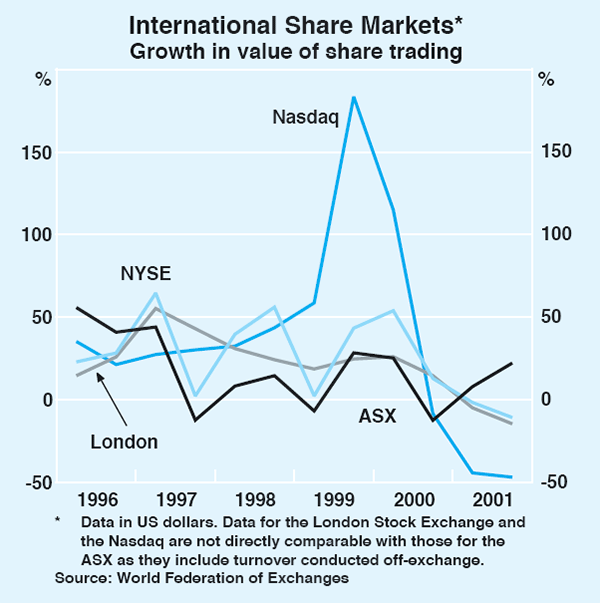
Box 1: Interest Rate Derivatives
An interest rate swap is an agreement between two parties to exchange interest rate obligations over a period of time. In its most common form – a fixed-to-floating rate swap – the parties agree to net off a fixed rate payment against a floating rate payment, with the difference being paid by one party to another. The floating rate payment is calculated using some daily benchmark (such as the Bank Bill Reference Rate) while the fixed rate is set at the time of the agreement. While swaps can be used for a number of purposes, one common use is to hedge exposure to interest rate movements.
As an example, assume the two parties to the swap contract have differing views on the way interest rates will move. One party may have a floating rate liability and will be worried that interest rates will rise (making its obligation more expensive). To protect against this eventuality, it can exchange its stream of floating rate payments with a fixed stream so as to ‘lock in’ existing interest rates. The other party would obviously adopt the reverse strategy. If interest rates rise, the party with the original floating rate obligation is compensated by the party with a fixed-rate obligation and vice versa if interest rates fall.
A forward rate agreement (FRA) is similar to an interest rate swap and is also used to hedge interest rate exposures. Under an FRA, however, the exchange of net interest rate obligations is based on rates that are determined at a specific point of time in the future, rather than on a daily basis over the life of the contract. It is often said that a swap is merely a series of FRAs.
As an example, suppose a borrower knows that in two months time it will need a three-month loan, and it wants to fix the rate on that loan now. In this case a bank might offer to sell the borrower a two-month FRA on a three-month bank bill rate (which would be called a ‘2 x 5’ month FRA) at say, 6 per cent. Two months later, the parties will exchange the net difference between the agreed fixed rate (6 per cent) and the prevailing three-month bank bill rate. If the bank bill rate is greater than 6 per cent, the bank will compensate the borrower and vice versa. Thus, the borrower has managed to hedge its exposure to rising interest rates, by ‘locking in’ the fixed rate of 6 per cent. Note, however, that if interest rates fall the borrower has incurred a cost.
An interest rate option is a contract which confers the right, but not the obligation, to buy or sell an underlying security – in this case a debt instrument.
A credit-default swap is a contract in which the seller agrees to compensate the swap buyer in the event that a specified borrower defaults. These and other credit derivative products offer the potential for better risk management of loan portfolios by the original lenders and for investors to diversify their credit exposures.
An overnight indexed swap (OIS) is a fixed-to-floating interest rate swap typically of one week to one year's maturity. The floating rate is referenced to the overnight cash rate, which is the rate that the RBA targets when setting monetary policy. At the end of the agreement, there is a single payment from one party to the other based on the notional principal of the swap. The payment reflects the net difference between the agreed fixed rate and the average of each day's actual cash rate over the term of the agreement. OIS are widely used by banks and other participants in the short-term money market to hedge their exposures to short-term interest rates, in much the same way as the swap example listed above.
Footnotes
The global results of the survey are available on the BIS web site under <http://www.bis.org/publ/rpfx02.htm>. Results for Australia can be accessed through the RBA web site under < http://www.rba.gov.au/media-releases/2001/>. [1]
Currency swaps are an agreement for the exchange of an equivalent amount of one currency against another. The exchange rates for both the first and second legs of the transaction are agreed simultaneously (and reflect interest differentials between the two relevant countries). As such they do not create a net currency exposure. Any changes to the exchange rate after the agreement is entered into are irrelevant to the outcome of the swap. They differ from cross-currency interest rate swaps as the latter do involve changes to foreign currency exposure. Cross-currency interest rate swaps also involve a change in the interest component of a loan from fixed to floating, or floating to fixed. [2]
See the Reserve Bank of Australia Bulletin, May 1996. [3]
Budget surpluses have also resulted in a sharp fall in the stock of Treasury notes outstanding, from around A$20 billion in 1996 to around A$5 billion. In its May 2002 Budget, the Commonwealth Government announced that it would no longer commit to maintain the volume of Treasury notes outstanding at a minimum of A$3 billion. Instead, issuance will be limited to that required for within-year financing purposes. [4]
The BIS survey found that banks accounted for only 31 per cent of total positions, compared with 55 per cent for other financial institutions and 14 per cent for non-financial users in June 2001. [5]
These figures are based on BIS, not AFMA, data so as to facilitate international comparisons. BIS estimates of OTC interest rate derivatives turnover are higher (at A$19.6 billion) than those obtained by AFMA (A$12.7 billion) mainly because BIS data include transactions dealt in Australia regardless of where they are booked and managed, while AFMA data include only transactions dealt, booked and managed in Australia. In addition, the BIS estimates are based on average turnover for the month of April, while the AFMA data are based on activity through the 12 months to June. [6]
The MSCI indices are based on the market capitalisation of the largest stocks in each broad industry group. [7]